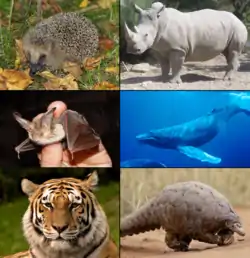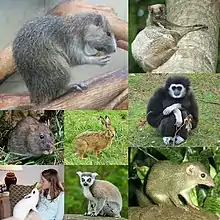北方真兽高目
北方真獸高目(學名:Boreoeutheria,來自古希臘語Βορέας,Boreas-“北方”,εὐ-,eu-“好,真”,θηρίον,thēríon“野獸”,因此是“北方真獸”之意),系胎盤哺乳動物之演化支,由勞亞獸總目(包括大多數有蹄類哺乳動物,大多數有爪食肉動物和其它幾個類群)和靈長總目 (超靈長類) 組成。現在,北方真獸高目的單系起源得到DNA序列分析以及有關反轉錄轉座子數據的充分支持[1]。該演化支之外的胎盤哺乳動物是異關節總目(樹懶及其近親)和非洲獸總目(大象及其近親)[2]。
| 北方真兽高目 化石时期:早期古新世 - 全新世, 65–0 Ma | |
|---|---|
 | |
 | |
| 科学分类 | |
| 界: | 动物界 Animalia |
| 门: | 脊索动物门 Chordata |
| 纲: | 哺乳纲 Mammalia |
| 亚纲: | 兽亚纲 Theria |
| 下纲: | 真兽下纲 Eutheria |
| 演化支: | 胎盘类 Placentalia |
| 高目: | 北方真兽高目 Boreoeutheria |
| 總目 | |
這一類動物的最早的化石可追溯到大約6500萬年前,即K-Pg滅絕事件後不久,儘管分子生物學數據表明,它們可能起源於更早的白堊紀時期。除了少數例外,此演化支的雄性動物有陰囊,有阴囊大目(Scrotifera)正是以該特徵命名的[3] [4][5]。
系统发生
根据分子遗传学的研究结果,北方真獸高目和其它真兽类的亲缘关系可能是:
| 真獸下綱 Eutheria |
| ||||||||||||||||||
根据大部分学者认可的猛兽有蹄类学说[2],北方真獸高目内部的演化关系可能是:
| |||||||||||||||||||||||||||||||||||||||
| 基於線粒體 DNA、核 DNA 與蛋白質特徵構建 |
參考文献
| 维基共享资源中相关的多媒体资源:北方真兽高目 |
| 维基物种中的分类信息:北方真兽高目 |
- Jaebum Kima, et al. Reconstruction and evolutionary history of eutherian chromosomes 页面存档备份,存于, Jaebum Kima, Marta Farréb, Loretta Auvilc, Boris Capitanuc, Denis M. Larkinb, Jian Mad, and Harris A. Lewine, Department of Biomedical Science and Engineering, Konkuk University, Seoul 05029, South Korea; Comparative Biomedical Science Department, Royal Veterinary College, University of London, London, NW1 0TU, United Kingdom; Illinois Informatics Institute, University of Illinois at Urbana–Champaign, Urbana, IL 61801; Computational Biology Department, School of Computer Science, Carnegie Mellon University, Pittsburgh, PA 15213; and Department of Evolution and Ecology, University of California, Davis, CA 95616
- Zhou, Xuming; Xu, Shixia; Xu, Junxiao; Chen, Bingyao; Zhou, Kaiya; Yang, Guang. . Systematic Biology. 2011, 61 (1): 150–164. PMC 3243735. PMID 21900649. doi:10.1093/sysbio/syr089.
- O'Leary, M. A.; Bloch, J. I.; Flynn, J. J.; Gaudin, T. J.; Giallombardo, A.; Giannini, N. P.; Cirranello, A. L. . Science. 2013, 339 (6120): 662–667. Bibcode:2013Sci...339..662O. PMID 23393258. hdl:11336/7302.
- Mills, D. S.; Marchant-Forde, Jeremy N. . CABI. 2010: 293– [20 June 2019]. ISBN 978-0-85199-724-7.
- Drew, Liam. . slate.com. 8 July 2013 [2020-09-29]. (原始内容存档于2018-09-30).
Between these branches, however, is where it gets interesting, for there are numerous groups, our descended but a-scrotal cousins, whose testes drop down away from the kidneys but don't exit the abdomen. Almost certainly, these animals evolved from ancestors whose testes were external, which means at some point they backtracked ... , evolving anew gonads inside the abdomen. They are a ragtag bunch including hedgehogs, moles, rhinos and tapirs, hippopotamuses, dolphins and whales, some seals and walruses, and scaly anteaters.
This article is issued from Wikipedia. The text is licensed under Creative Commons - Attribution - Sharealike. Additional terms may apply for the media files.